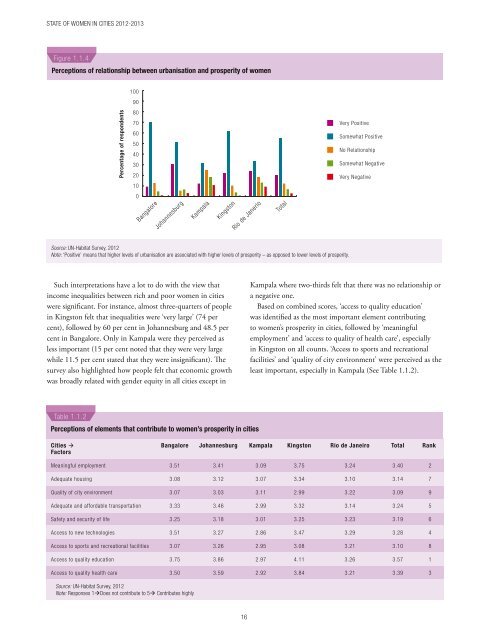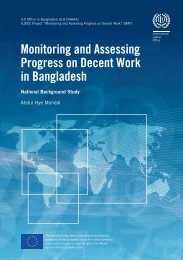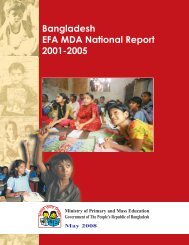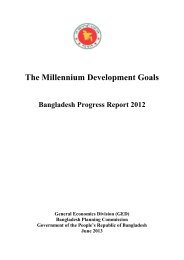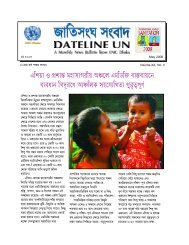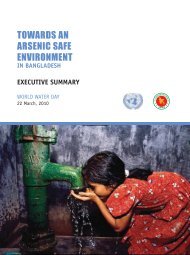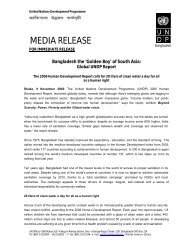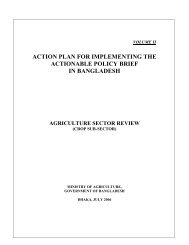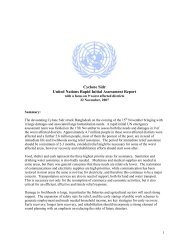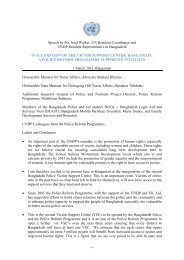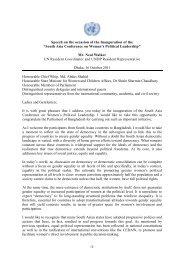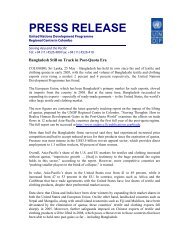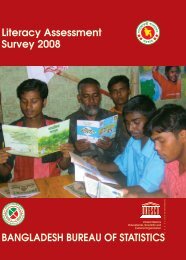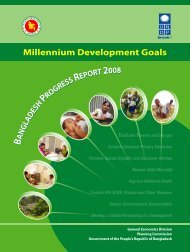STATE OF WOMEN IN CITIES 2012-2013 - UN-Habitat
STATE OF WOMEN IN CITIES 2012-2013 - UN-Habitat
STATE OF WOMEN IN CITIES 2012-2013 - UN-Habitat
You also want an ePaper? Increase the reach of your titles
YUMPU automatically turns print PDFs into web optimized ePapers that Google loves.
<strong>STATE</strong> <strong>OF</strong> <strong>WOMEN</strong> <strong>IN</strong> <strong>CITIES</strong> <strong>2012</strong>-<strong>2013</strong><br />
Figure 1.1.4<br />
Perceptions of relationship between urbanisation and prosperity of women<br />
100<br />
90<br />
Percentage of respondents<br />
80<br />
70<br />
60<br />
50<br />
40<br />
30<br />
20<br />
10<br />
Very Positive<br />
Somewhat Positive<br />
No Relationship<br />
Somewhat Negative<br />
Very Negative<br />
0<br />
Bangalore<br />
Johannesburg<br />
Kampala<br />
Kingston<br />
Rio de Janerio<br />
Total<br />
Source: <strong>UN</strong>-<strong>Habitat</strong> Survey, <strong>2012</strong><br />
Note: ‘Positive’ means that higher levels of urbanisation are associated with higher levels of prosperity – as opposed to lower levels of prosperity.<br />
Such interpretations have a lot to do with the view that<br />
income inequalities between rich and poor women in cities<br />
were significant. For instance, almost three-quarters of people<br />
in Kingston felt that inequalities were ‘very large’ (74 per<br />
cent), followed by 60 per cent in Johannesburg and 48.5 per<br />
cent in Bangalore. Only in Kampala were they perceived as<br />
less important (15 per cent noted that they were very large<br />
while 11.5 per cent stated that they were insignificant). The<br />
survey also highlighted how people felt that economic growth<br />
was broadly related with gender equity in all cities except in<br />
Kampala where two-thirds felt that there was no relationship or<br />
a negative one.<br />
Based on combined scores, ‘access to quality education’<br />
was identified as the most important element contributing<br />
to women’s prosperity in cities, followed by ‘meaningful<br />
employment’ and ‘access to quality of health care’, especially<br />
in Kingston on all counts. ‘Access to sports and recreational<br />
facilities’ and ‘quality of city environment’ were perceived as the<br />
least important, especially in Kampala (See Table 1.1.2).<br />
Table 1.1.2<br />
Perceptions of elements that contribute to women’s prosperity in cities<br />
Cities à<br />
Factors<br />
Bangalore Johannesburg Kampala Kingston Rio de Janeiro Total Rank<br />
Meaningful employment 3.51 3.41 3.09 3.75 3.24 3.40 2<br />
Adequate housing 3.08 3.12 3.07 3.34 3.10 3.14 7<br />
Quality of city environment 3.07 3.03 3.11 2.99 3.22 3.09 9<br />
Adequate and affordable transportation 3.33 3.46 2.99 3.32 3.14 3.24 5<br />
Safety and security of life 3.25 3.18 3.01 3.25 3.23 3.19 6<br />
Access to new technologies 3.51 3.27 2.86 3.47 3.29 3.28 4<br />
Access to sports and recreational facilities 3.07 3.26 2.95 3.08 3.21 3.10 8<br />
Access to quality education 3.75 3.86 2.97 4.11 3.26 3.57 1<br />
Access to quality health care 3.50 3.59 2.92 3.84 3.21 3.39 3<br />
Source: <strong>UN</strong>-<strong>Habitat</strong> Survey, <strong>2012</strong><br />
Note: Responses 1àDoes not contribute to 5à Contributes highly<br />
16


